Dry, Hot American Summer
Wildland fires are a natural part of a healthy ecosystem. By removing old or dead vegetation, they stimulate new growth and improve wildlife habitats. But wildland fires can also be destructive and deadly.
With fires raging in California, today’s WatchBlog turns its attention to the costs and challenges of federal wildfire management.
Image

Fueling the fire
Over the past century, land management practices such as fire suppression, grazing, and timber harvesting have reduced the normal frequency of fires. Without naturally occurring fires, vegetation has grown unnaturally dense, creating conditions for potentially bigger, more severe fires. Add to this drought and other environmental stresses, and many scientists expect fires to become more frequent and more severe. What’s more, continuing development near wildlands raises the risk of fires destroying private property and endangering people’s lives.
Firefighting on a budget
As you can imagine, preparing for and fighting wildland fires is costly. From fiscal years 2004 through 2014, the 5 federal agencies responsible for managing wildfires on federal land—the Forest Service, Bureau of Indian Affairs, Bureau of Land Management, Fish and Wildlife Service, and National Park Service—obligated (in current dollars):
- $14.9 billion for suppression—managing wildland fires as they occur, including fighting fires.
- $13.4 billion for preparedness—buying and maintaining fire engines and aircraft.
- $5.7 billion for fuel reduction—reducing potentially hazardous vegetation that can fuel fires.
Of course, the unpredictable nature of fire makes it hard to budget for suppression. For example, agencies obligated $809 million for suppression in fiscal year 2010, but more than doubled that to $1.9 billion in fiscal year 2012.
For preparedness and fuel reduction, these 5 agencies distribute their resources based in part on historical amounts. So while the nature and severity of fires have changed, the same number of fire engines, crews, and other resources have remained mostly the same.
Agencies are developing new systems to better distribute resources to match current fire conditions. However, until those systems are complete, the agencies continue to rely on their ability to move resources around as situations arise.
Trial by fire
All 5 agencies are trying to better manage wildland fires, in part by reviewing their responses to past fires. However, some agency officials told us that the reviews focused more on the cost of fire suppression than its effectiveness and agencies haven’t updated their policies to put more emphasis on effectiveness.
We made two recommendations to improve how the agencies conduct their reviews.
- Comments on GAO’s WatchBlog? Contact blog@gao.gov.
GAO Contacts
Related Products

GAO's mission is to provide Congress with fact-based, nonpartisan information that can help improve federal government performance and ensure accountability for the benefit of the American people. GAO launched its WatchBlog in January, 2014, as part of its continuing effort to reach its audiences—Congress and the American people—where they are currently looking for information.
The blog format allows GAO to provide a little more context about its work than it can offer on its other social media platforms. Posts will tie GAO work to current events and the news; show how GAO’s work is affecting agencies or legislation; highlight reports, testimonies, and issue areas where GAO does work; and provide information about GAO itself, among other things.
Please send any feedback on GAO's WatchBlog to blog@gao.gov.





